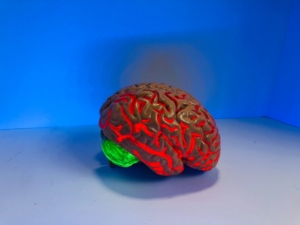The Practice of Renewing Your Mind Through Principles from Cognitive Behavioral Therapy
What is Cognitive Behavioral Therapy? How can it help you? In this article, I’ll answer these questions and more.
Do not be conformed to this world, but be transformed by the renewal of your mind, that by testing you may discern what is the will of God, what is good and acceptable and perfect. – Romans 12:2
It is interesting, this idea of transformation by the renewal of your mind. What does it mean? Is it even possible?
 The human brain is an amazing phenomenon. It is capable of so many incredible and complicated things, but it can also be a place of great struggle. Human beings fight battles in their minds daily. They battle cognitive distortions that can greatly impact emotions and behavior. Newport Beach Christian Counseling offers support to help you understand and manage these cognitive distortions, bringing clarity and peace to your mind and life.
The human brain is an amazing phenomenon. It is capable of so many incredible and complicated things, but it can also be a place of great struggle. Human beings fight battles in their minds daily. They battle cognitive distortions that can greatly impact emotions and behavior. Newport Beach Christian Counseling offers support to help you understand and manage these cognitive distortions, bringing clarity and peace to your mind and life.
In fact, the Cognitive Triangle (a foundational principle in Cognitive Behavioral Therapy) shows that thoughts, emotions, and behaviors are all interconnected and mutually impact the others. Cognitive distortions are the ways that one’s mind convinces him or her of something that is not true, rational, or even helpful. Some have identified ten cognitive distortions, but we will consider fourteen.
What are the Common Cognitive Distortions?
Filtering: when someone filters out (or even ignores) the good or positive aspects of a situation and focuses solely on the negative.
Black and White Thinking: when someone sees no middle ground or gray area, seeing all or nothing. Something is either this or that, there is nothing in between.
Overgeneralization: when someone comes to a general conclusion about something based on a single experience.
Jumping to Conclusions: when someone assumes that he or she understands the thoughts or behaviors or feelings of another person without evidence. This could also apply to situations, not just in relationships.
Catastrophizing: when someone thinks about the worst-case scenario in most situations. They put magnitude on situations that are more minimal. They get lost in the “what ifs.”
Personalization: when someone believes that situations or interactions with others are always related to something about them on a personal level. It becomes “all about them,” to an extent.
 Control Fallacies: when someone believes the illusion of being in control of everything in their life (whether internally or externally).
Control Fallacies: when someone believes the illusion of being in control of everything in their life (whether internally or externally).
Fallacy of Fairness: when someone is hyper-focused on what he or she believes to be fair and expects others to follow this. When something is “unfair,” a person with this distortion will often become angry.
Blaming: when someone holds others responsible for his or her emotions or emotional experiences.
Shoulds: when someone has a list of rules (dos and don’ts) that they believe they must follow for a certain reason. This person will tend to get angry when they, themselves or others do not follow these shoulds and often feel guilt and shame as well.
Emotional Reasoning: when someone believes that if they feel something, it must be true, instead of understanding that emotions are not always indicative of what is true or accurate.
Fallacy of Change: when someone feels the need to change others because the success of others depends entirely on this person. They often pressure others to change because they believe it is what is best from them.
Global Labeling: when someone generalizes one or two negative qualities about a person, group of people, environment, or situation to mean that the whole is negative.
Always Being Right: when someone constantly tests others in order to prove that he or she is right about a topic. For this person, being wrong is unthinkable. (from PsychCentral, 15 Common Cognitive Distortions)
Looking at this list can be a bit overwhelming because you probably notice that you struggle with several of these distortions, but it is possible to change the course of these thought patterns. It is possible to renew the mind, to travel down a different thought path that is more accurate, helpful, and true. This is where other principles from Cognitive Behavioral Therapy can come in.
Cognitive Behavioral Therapy (CBT): What is it?
 Cognitive Behavioral Therapy is an evidence-based form of psychotherapy that focuses on thought patterns- what they are, how to evaluate them, and how to replace them with more accurate and helpful thoughts. The goal is for the altered thoughts to then positively affect one’s emotions and behaviors (as stated earlier about the Cognitive Triangle).
Cognitive Behavioral Therapy is an evidence-based form of psychotherapy that focuses on thought patterns- what they are, how to evaluate them, and how to replace them with more accurate and helpful thoughts. The goal is for the altered thoughts to then positively affect one’s emotions and behaviors (as stated earlier about the Cognitive Triangle).
It not only focuses on evaluating and replacing thoughts but also on calming skills and other ways to cope with some uncomfortable emotions as well as some behavior therapy to manage unhealthy behaviors.
It is based on several core principles as found in the Cognitive Triangle (list from apa.org, What is Cognitive Behavioral Therapy):
- Psychological problems are based, in part, on faulty or unhelpful ways of thinking. (Cognitive Distortions)
- Psychological problems are based, in part, on learned patterns of unhelpful behavior.
- People suffering from psychological problems can learn better ways of coping with them, thereby relieving their symptoms and becoming more effective in their lives.
Interventions for Cognitive Restructuring
Since the focus of this article is mainly on thought patterns, the interventions discussed will also focus on cognitive restructuring exercises. There are many other interventions that help one manage emotions and behavior, though, in CBT.
Identification of Cognitive Distortions
You will sometimes have automatic thoughts that pop into your head. You might even think, “Why am I thinking this thought?” or “Where did this thought come from?” These thoughts become automatic because they are the road most traveled in your brain.
For example, when you drive you have often thought about the possibility of being in a car accident, so now every time you get into your car, these thoughts of a car accident pop into your head and lead to high anxiety. Cognitive distortions can become automatic when you allow your brain to go too far down that path.
Part of redirecting thought patterns down a new and more helpful and accurate path of thinking is to simply pay attention to what those thoughts are and understand what distortions are present. Therefore, it is valuable to know what the common cognitive distortions are to be aware of what they are for you.
Identification of Feelings
Feelings and thoughts are interconnected, so it is vital to pay attention to the feelings you are having in a situation. Pull out a feelings wheel (easily accessible through Google), and then find the most prominent feelings that you are experiencing in a certain situation. Rate them. How intense are they on a scale from 1-100?
Evaluate the Thought Patterns/Distortions
This is when you would need to ask yourself some questions about the thoughts you have noticed in a situation. Is this thought accurate? Is this thought helpful? Is this thought necessary? Is there any evidence that supports this thought? Is there any evidence that does not support this thought?
Replace the thought with a more accurate, realistic, or helpful thought
 After evaluation, it is necessary to replace. This is how you can literally renew your mind. This is how to train your brain to think differently. For example, instead of allowing yourself to automatically think about getting in a car accident every time you get in your car (which leads to anxiety), you could think something like this, “Well, I do not know anything that will happen in the future. All I know is that right now, I am safe.”
After evaluation, it is necessary to replace. This is how you can literally renew your mind. This is how to train your brain to think differently. For example, instead of allowing yourself to automatically think about getting in a car accident every time you get in your car (which leads to anxiety), you could think something like this, “Well, I do not know anything that will happen in the future. All I know is that right now, I am safe.”
This is a more helpful thought. The more you replace unhelpful or inaccurate thoughts, the more your brain will stop going to those thoughts automatically and will start moving in a healthier direction.
Identification of Feelings after Replacing the Thought
Now that you have found a healthier way of looking at the situation, how you do feel? Has the intensity of your emotion decreased?
Identification of Behaviors
Now how do you act? Example: when you ruminate on your thoughts and fears about driving, sometimes you get out of the car and completely avoid driving. When you evaluate and replace unhelpful thoughts, your anxiety goes down and you can drive your car.
This is the basic structure of a thought log (or thought record) which is simply a chart that leads you step-by-step through this process. There are many examples of thought records on Google that you can find to help you.
Christian Counseling Using Cognitive Behavioral Therapy
However, people often struggle with this and find themselves stuck. A counselor at Newport Beach Christian Counseling who is familiar with or trained in Cognitive Behavioral Therapy (CBT) can help you through this process. They can help you see things that you cannot see yet, and this therapy is proven to be helpful in treating many mental disorders along with other mental health issues.
If you are struggling with your thoughts, behaviors, and emotions in some way, CBT may be the right fit for you. Maybe it is time to be “transformed by the renewing of your mind.” The growth and healing that can occur can be exponential.
https://psychcentral.com/lib/15-common-cognitive-distortions/
https://www.apa.org/ptsd-guideline/patients-and-families/cognitive-behavioralPhotos:
“This Is Your Brain…”, Courtesy of Natasha Connell, Unsplash.com, CC0 License; “Prayer,” Courtesy of Ben White, Unsplash.com, CC0 License; “Pointing the Finger”, Courtesy of Adi Goldstein, Unsplash.com, CC0 License; “Isolation”, Courtesy of Guilherme Stecanella, Unsplash.com, CC0 License





